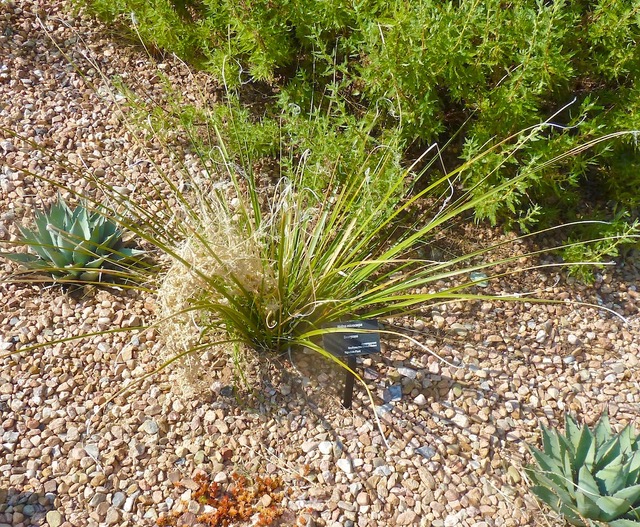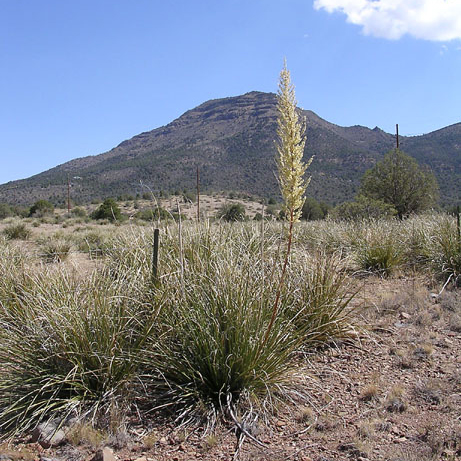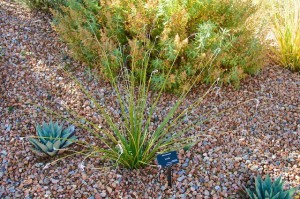Scientific name: Nolina microcarpa, Nolina species
Common names: beargrass, sacahuista, palmilla, small-seed nolina
Plant family: Asparagaceae – asparagus
USDA Zones 6b-10
Article and photos by Janice Tucker
Looks can be deceiving. The species of the Nolina genus are living proof. But whether Nolinas are established in a garden or thriving in their native habitat, these succulents often unintentionally pass for ornamental grasses. This masquerade is further perpetuated by the common name of beargrass, which is applied to all Nolinas. And while they are definitely not grasses, they can pull off a convincing imitation. This trait turns out to be an asset in gardens located in the dry climate of the southwestern United States. The genetic properties of the Nolinas are adept in handling drought, poor soil and temperature swings while satisfying a landscaper’s design vision for ornamental grasses.

Photo by Janice Tucker
Although it has been introduced to other regions as a garden plant, the Nolina microcarpa limits its native status to New Mexico, Arizona, southeastern Utah and northern Mexico. A fountain of gracefully curving, olive green leaves with closely serrated margins rises directly from the earth, anchored by a deep-rooted, below-the-ground stem known as a caudex. Flexible, curly fibers dangle from the leaf tips, dancing playfully in the wind, conveying an animation not often found in the rigidity of succulents. As the seasons unfold, the Nolina microcarpa continues to reveal its distinctive characteristics. In early to mid-summer, a scape of panicles covered with hundreds of tiny, white flowers ascends from the caudex to tower above the leaves. The flowers evolve into attractive, small, translucent, three-sided seed capsules. Because it is an evergreen, the leaves lend continuous color interest year-round, especially welcome when their soft green hue contrasts beautifully with a monochromatic winter landscape.
The gardeners who toil in our dry climate of hot summers, cold winters and high elevations will gladly embrace the Nolina microcarpa. It not only tolerates the hot, arid summers and cold winters of the southwestern United States, it demands those conditions. Thriving in elevations of 3,000 to 7,000 feet it soldiers on through high summer heat that morphs into winter temperatures that dip down to -15 degrees Fahrenheit.
 The Nolina microcarpa absolutely loves to bask in full sun but will acquiesce to partial shade if necessary. Allow its roots to rest in sandy loam with good drainage and forget about fertilizer. Xeric gardeners will welcome the N. microcarpa’s disdain for supplemental water. After all, it only receives moisture in its natural habitat when the heavens deign to open up with the occasional rainfall. When planting be sure to allocate enough room for the N. microcarpa to reach its mature height of 6 to 7 feet and width of 4 to 6 feet. Spring or fall is the best time for planting. Since the N. microcarpa is dioecious you may want to purchase a male and a female plant. Its growth habit can be variable so be prepared for some visual differences when comparing to nursery images. Heads up when purchasing any Nolina: Be aware that there is a totally unrelated plant called “common beargrass” (Xerophyllum tenax) in the corn lily (Melanthiaceae) family. Specify purchases by scientific plant names to avoid confusion. The Nolina microcarpa’s sweet flower nectar is irresistible to hummingbirds. Other birds feast on the seeds. But deer? They turn up their noses and pass it by…say Hallelujah!
The Nolina microcarpa absolutely loves to bask in full sun but will acquiesce to partial shade if necessary. Allow its roots to rest in sandy loam with good drainage and forget about fertilizer. Xeric gardeners will welcome the N. microcarpa’s disdain for supplemental water. After all, it only receives moisture in its natural habitat when the heavens deign to open up with the occasional rainfall. When planting be sure to allocate enough room for the N. microcarpa to reach its mature height of 6 to 7 feet and width of 4 to 6 feet. Spring or fall is the best time for planting. Since the N. microcarpa is dioecious you may want to purchase a male and a female plant. Its growth habit can be variable so be prepared for some visual differences when comparing to nursery images. Heads up when purchasing any Nolina: Be aware that there is a totally unrelated plant called “common beargrass” (Xerophyllum tenax) in the corn lily (Melanthiaceae) family. Specify purchases by scientific plant names to avoid confusion. The Nolina microcarpa’s sweet flower nectar is irresistible to hummingbirds. Other birds feast on the seeds. But deer? They turn up their noses and pass it by…say Hallelujah!
The Nolina genus is named in honor of Abbé Pierre Charles Nolin, an 18th century French arborist and agricultural writer. According to Stearn’s Dictionary of Plant Names for Gardeners, Nolina is defined as bear-grass (or beargrass). Describing these plants as grasses is understandable but where did “bear” originate?
Perhaps the most charming of the common names is sacahuista, a combination of two Aztec words: “zacatl” (grass) and “huitztli” (thorn). This name is descriptive of the grass-like appearance and the sharp, saw-toothed leaf margins. An Aztec name is most appropriate considering that the natural habitats for most of the 28 Nolina species are located in Mexico. Another common name is palmilla, the Spanish diminutive of “palm”. The Nolina microcarpa is also commonly known as the small-seed nolina in reference to its tiny, three-sided seeds. While small-seed nolina may be the most descriptive of the common names, beargrass, sacahuista and palmilla tend to capture the soul of the Nolina microcarpa.

Nolina microcarpa (Photo by Janice Tucker)
At this time, the Nolina microcarpa is a protected plant in Arizona where harvesting is restricted. But if it is protected in one native area, then wouldn’t it be prudent to do the same in any area where it grows naturally? Maybe its ethnobotanical uses should be relegated to the past for the time being. However, it is fascinating to go back in time to learn how plants were originally incorporated into the lives of Native Americans and early Spanish settlers. Their ingenuity in discovering the best plants for clothing, shelter, woven goods, medicine and food is embroidered throughout the fabric of their rich histories. The Nolina microcarpa demonstrated its usefulness in several ways. The leaves provided material for mats, baskets, cords and thatch. The seeds were eaten raw and were the base for flour and meal. The roots contain the necessary elements for soap and as an ingredient in decoctions to treat various ailments such as pneumonia and rheumatism.
The Nolina microcarpa adds structure and style to a garden whether planted in groups, standing alone or among companion plants. The Botanical Garden at Museum Hill affords visitors the opportunity to observe how the Nolina microcarpa enhances a garden. It grows in the xeric gardens and alongside other native plants in the Ojos y Manos addition.
So now we know. The beargrass (Nolina microcarpa) is not a grass even though it’s called a grass and it looks like a grass. It is a hardy succulent – albeit a grassy-looking one – that displays an aesthetic, year-round appeal in a Santa Fe garden while demanding very little maintenance in return. Can’t ask for more than that.
Thanks to Helen Woody and Jeanne Gozigian for proofreading this article.
Sources consulted and/or cited:
Flora of North America website, efloras.org: Nolina microcarpa.
Lady Bird Johnson Wildflower Center website, Nolina microcarpa.
Native American Ethnobotany database, Nolina microcarpa.
Phillips, Judith, New Mexico Gardener’s Guide.
Salman, David, High Country Gardens website blog, Beargrass: A Drought Resistant Treasure for Dry Landscapes.
SIENet– Arizona –New Mexico Chapter website, Nolina microcarpa description and photograph, nolina_microcarpa_habit Leslie Landrum swbiodiviserity.org.
Southeastern Arizona Wildflowers and Plants website, Nolina microcarpa – Sacahuista.
Stearn, William T, Stearn’s Dictionary of Plant Names for Gardeners.
- S. Forest Service website, Nolina microcarpa.


